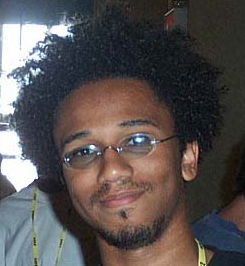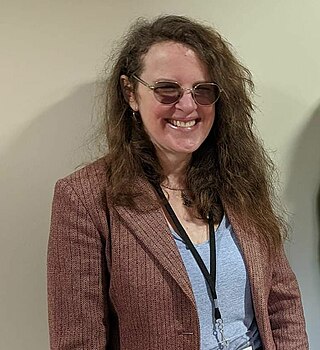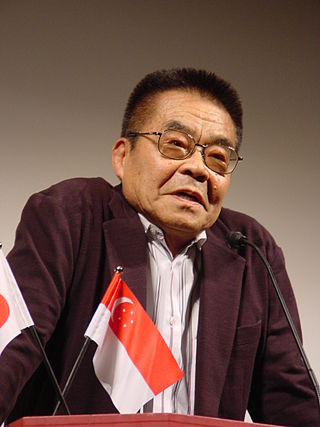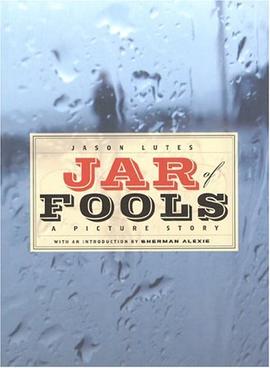
The Phantom is an American adventure comic strip, first published by Lee Falk in February 1936. The main character, the Phantom, is a fictional costumed crime-fighter who operates from the fictional African country of Bangalla. The character has been adapted for television, film and video games.

Linda Jean Barry, known professionally as Lynda Barry, is an American cartoonist. Barry is best known for her weekly comic strip Ernie Pook's Comeek. She garnered attention with her 1988 illustrated novel The Good Times are Killing Me, about an interracial friendship between two young girls, which was adapted into a play. Her second illustrated novel, Cruddy, first appeared in 1999. Three years later she published One! Hundred! Demons!, a graphic novel she terms "autobifictionalography". What It Is (2008) is a graphic novel that is part memoir, part collage and part workbook, in which Barry instructs her readers in methods to open up their own creativity; it won the comics industry's 2009 Eisner Award for Best Reality-Based Work.

Aaron Vincent McGruder is an American writer, cartoonist, and producer best known for creating The Boondocks, a Universal Press Syndicate comic strip and its animated TV series adaptation.

Daniel Gillespie Clowes is an American cartoonist, graphic novelist, illustrator, and screenwriter. Most of Clowes's work first appeared in Eightball, a solo anthology comic book series. An Eightball issue typically contained several short pieces and a chapter of a longer narrative that was later collected and published as a graphic novel, such as Like a Velvet Glove Cast in Iron (1993), Ghost World (1997), David Boring (2000) and Patience (2016). Clowes's illustrations have appeared in The New Yorker, Newsweek, Vogue, The Village Voice, and elsewhere. With filmmaker Terry Zwigoff, Clowes adapted Ghost World into a 2001 film and another Eightball story into the 2006 film, Art School Confidential. Clowes's comics, graphic novels, and films have received numerous awards, including a Pen Award for Outstanding Work in Graphic Literature, over a dozen Harvey and Eisner Awards, and an Academy Award nomination.

Nancy is an American comic strip, originally written and drawn by Ernie Bushmiller and distributed by United Feature Syndicate and Andrews McMeel Syndication. Its origins lie in Fritzi Ritz, a strip Bushmiller inherited from its creator Larry Whittington in 1925. After Fritzi's niece Nancy was introduced in 1933, Fritzi Ritz evolved to focus more and more on Nancy instead of Fritzi. The new strip took the old one's daily slot, while Fritzi Ritz continued as a Sunday, with Nancy taking the Sunday slot previously filled by Bushmiller's Phil Fumble strip beginning on October 30, 1938.
An autobiographical comic is an autobiography in the form of comic books or comic strips. The form first became popular in the underground comix movement and has since become more widespread. It is currently most popular in Canadian, American and French comics; all artists listed below are from the U.S. unless otherwise specified.

Weirdo was a magazine-sized comics anthology created by Robert Crumb and published by Last Gasp from 1981 to 1993. Featuring cartoonists both new and old, Weirdo served as a "low art" counterpoint to its contemporary highbrow Raw, co-edited by Art Spiegelman.

Drawn & Quarterly is a publishing company based in Montreal, Quebec, Canada, specializing in comics. It publishes primarily comic books, graphic novels and comic strip collections. The books it publishes are noted for their artistic content, as well as the quality of printing and design. The name of the company is a pun on "drawing", "quarterly", and the practice of hanging, drawing and quartering. Initially it specialized in underground and alternative comics, but has since expanded into classic reprints and translations of foreign works. Drawn & Quarterly was the company's flagship quarterly anthology during the 1990s.
An alternative newspaper is a type of newspaper that eschews comprehensive coverage of general news in favor of stylized reporting, opinionated reviews and columns, investigations into edgy topics and magazine-style feature stories highlighting local people and culture. Its news coverage is more locally focused, and their target audiences are younger than those of daily newspapers. Typically, alternative newspapers are published in tabloid format and printed on newsprint. Other names for such publications include alternative weekly, alternative newsweekly, and alt weekly, as the majority circulate on a weekly schedule.
Joe Matt was an American cartoonist, best known for his autobiographical work, Peepshow.

William Henry Jackson Griffith is an American cartoonist who signs his work Bill Griffith and Griffy. He is best known for his surreal daily comic strip Zippy. The catchphrase "Are we having fun yet?" is credited to Griffith.

Julie Doucet is a Canadian underground cartoonist and artist, best known for her autobiographical works such as Dirty Plotte and My New York Diary. Her work is concerned with such topics as "sex, violence, menstruation and male/female issues."
The comic strip switcheroo was a massive practical joke in which several comic strip writers and artists (cartoonists), without the foreknowledge of their editors, traded strips for a day on April Fools' Day 1997. The Switcheroo was masterminded by comic strip creators Rick Kirkman and Jerry Scott, creators of the Baby Blues daily newspaper comic strip.

Yoshihiro Tatsumi was a Japanese manga artist whose work was first published in his teens, and continued through the rest of his life. He is widely credited with starting the gekiga style of alternative manga in Japan, having allegedly coined the term in 1957. His work frequently illustrated the darker elements of life.
M. K. Brown is an American cartoonist and painter whose work has appeared in many publications, including National Lampoon (1972–1981), Mother Jones, Wimmen's Comix, The New Yorker, Playboy, among others. She has written several books, created animations for The Tracey Ullman Show, and was a contributing artist to the "comic jam" graphic novel The Narrative Corpse. She is also an accomplished painter with work in galleries and many private collections.

Conan the Barbarian by Robert E. Howard was first adapted into comics in 1952 in Mexico. Marvel Comics began publishing Conan comics with the series Conan the Barbarian in 1970. Dark Horse Comics published Conan from 2003 to 2018, when the rights were reacquired by Marvel Comics. Marvel published Conan comics until 2022, and Titan Comics took over the license from Heroic Signatures to begin publishing its own series.

Lee Marrs is an American cartoonist and animator, and one of the first female underground comix creators. She is best known for her comic book series The Further Fattening Adventures of Pudge, Girl Blimp, which lasted from 1973 to 1977.

Jar of Fools is a once-weekly comic strip by Jason Lutes that was compiled, first into a two-part anthology, and then a graphic novel. The work has received praise from The New York Times Book Review, Spin, Wired, and acclaimed comics creator Chris Ware.

Jillian Tamaki is a Canadian American illustrator and comic artist known for her work in The New York Times and The New Yorker in addition to the graphic novels Boundless, as well as Skim and This One Summer written by her cousin Mariko Tamaki.

Michael DeForge is a Canadian comics artist and illustrator.